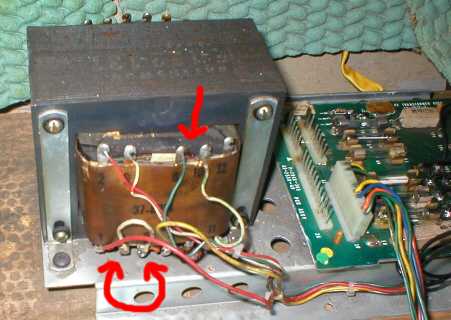
|
Bally Space
Invaders Pinball
|

|
Restoration All content on this site Copyright ©2002-2006 Dave Pinx. All rights reserved. |
![]()
 |
 |
 |
 |
 |
![]()
|
It's
here.... First
impressions, well cosmetically its got to be very close to a 8 out
of 10, it is extremely clean and the backbox infinity glass and artwork
is unmarked. The playfield has just a little wear, but this has already
been re-painted, the game itself is complete, so it was a very good
buy ! ! All notes here are for my reference only, i will not be held responsible for any mistakes / damage done to your Pinball Machine ! |
|
Where
to start...
As i already knew the power supply had wire problems, i decided to start here first and as you can see , its a beefy bugger. It consists of a large 240v ac transformer and a rectifier pcb, which has 3 connections to the pinball. J1 Playfield connector, J2 cabinet connector, J3 Backbox connector. These connectors on some pins suffer badly from getting too hot and badly burnt pins are very common. Whilst i had it on the bench, i got the manual out and checked the transformers pinouts and for UK 240v use lugs 3 and 5 should be tied with a jumper wire, but for some unknown reason this one had lugs 3 and 9 tied ! So this i changed immediately. |
 |
![]()
 |
Burnt
connections.
I then turned my attention to the large 20 pin conncetor at J3, which i could see was showing signs of burning, so i removed the loom from the table so i could work on it easier, this connector was the one which had been label'd and had 2 wires hanging out. Using a small flat bladed screwdriver i unpined all the pins from the badly burnt connector, which had burnt that much it had cracked almost in two ! (See pic) |
![]()
|
Burnt
connections cont....
I couldnt get a new 20 slot replacement connector so i went for two 10's instead and marked the connectors with paint pen showing pins 1 and 10 and pins 11 and 20, so at a glance i knew which was which. After replacing the wires in the new connectors and fitting new pins, i thought it best to check the wiring against the manual, as i couldnt be sure that who ever had label'd them had done the job properly. I found out that this was a wise move, as 4 of the wires were in the wrong places and i mean miles out of place. So now i am expecting other pcb's within the game to be faulty, if the previous owner had been turning it on with the wires as they were, it has probably done some damage. |
 |
![]()
 |
Power
supply rectifier pcb.
|
![]()
|
Bridge
rectifiers. |
 |
![]()
 |
Rectifier
pcb modifications. |
![]()
|
Testing
the power supply.
TP1= 8.2
vdc |
 |
![]()
 |
Transformer
problems. *Note bottom arrows in pic shows lugs 3 and 5 tied for UK 240V use. |
![]()
|
Backbox
Game pcb's. |
 |
![]()
 |
Mpu
pcb testing. |
![]()
|
MPU
pcb ground modification.
This pcb also needs to have a jumper mod done to relieve burning to pins 18 and 19 on connection J4 as this is the only place the the MPU pcb gets its ground from the power supply. So i added a small black jumper from pins 18 and 19 on the solder side of the pcb to the large ground trace to the right of them. (see pic). |
 |
![]()
 |
MPU
pcb Battery removal.
These are nothing but trouble, as they leak corrosive acid on the pcb, which in some cases can spread quite badly, i have been lucky as the one on my machine had only leaked a little bit and not reached any components surrounding it. I am going to replace this with a 1 Farad memory capacitor, as you can fit it and never worry about leakage again. |
![]()
Click here for Page two
Or click here for Home